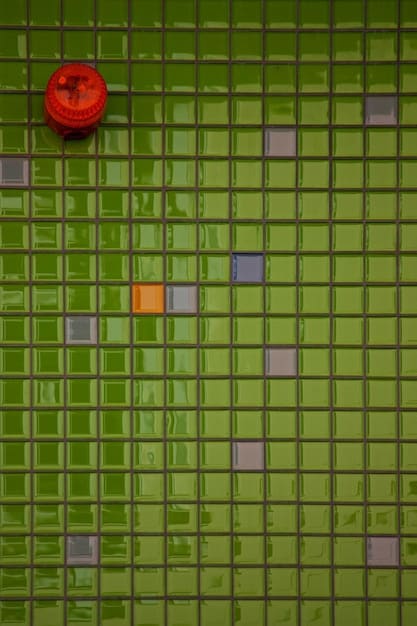AI Pathfinding for Beginners: Implement A* Algorithm in Your Game Today

The A* algorithm effectively guides game AI by finding the most efficient path between two points, balancing distance and heuristic estimates to simulate intelligent decision-making for non-player characters.
Embark on a journey into the heart of artificial intelligence in game development as we explore AI Pathfinding for Beginners: Implement A* Algorithm in Your Game Today. Understanding how non-player characters navigate game worlds is crucial for creating immersive and believable experiences.
The Essence of Game AI Pathfinding
Pathfinding is fundamental to game AI, allowing non-player characters (NPCs) to move intelligently through virtual environments. Without effective pathfinding, NPCs would appear illogical, often getting stuck or taking inefficient routes, which can significantly detract from a player’s experience. This section delves into why pathfinding is so vital and introduces the context for the A* algorithm.
Modern games demand sophisticated navigation. From enemies chasing players through intricate levels to friendly characters reaching their destinations, the underlying logic for movement is almost always powered by a pathfinding algorithm. This isn’t just about moving from point A to point B; it’s about doing so efficiently, realistically, and adapting to dynamic environments.
Why Pathfinding Matters
Effective pathfinding contributes directly to game quality and player immersion. Consider a real-time strategy game where units need to navigate complex terrain, or a role-playing game where companions follow the player. Flawless movement enhances realism, making the game world feel more alive and responsive to player actions.
- Enhanced Player Experience: NPCs that move intelligently contribute to a more convincing and challenging gameplay.
- Dynamic Environment Adaptation: Robust pathfinding allows AI to react to changes, like opening doors or collapsing bridges.
- Reduced Player Frustration: Smooth, logical AI movement prevents players from feeling like the game’s AI is “dumb” or easily exploitable.
- Core Gameplay Mechanic: In many genres, like stealth or strategy, pathfinding is a central element of the gameplay loop.
The core challenge lies in balancing computational efficiency with navigational accuracy. Complex maps with many obstacles require algorithms that can process vast amounts of data quickly, ensuring the game runs smoothly without noticeable lag. This is where algorithms like A* shine, offering a smart compromise between speed and optimal path discovery.
Ultimately, pathfinding isn’t just a technical detail; it’s a critical component in crafting memorable and engaging interactive experiences. By giving virtual characters the ability to navigate intelligently, developers can build more complex worlds and more compelling narratives.
Understanding the A* Algorithm: The Basics
The A* algorithm stands out as one of the most widely used and efficient pathfinding algorithms in game development. It’s an informed search algorithm, meaning it uses a heuristic function to guide its search, making it significantly faster than uninformed search algorithms like Breadth-First Search (BFS) or Dijkstra’s algorithm in many scenarios. This section breaks down the fundamental concepts behind A*.
At its core, A* combines aspects of Dijkstra’s algorithm and Greedy Best-First Search. It finds the shortest path between a starting node and a target node in a graph, considering both the cost to reach a given node from the start (g-score) and the estimated cost to reach the target from that node (h-score). The sum of these two scores, the f-score, guides the algorithm’s decisions.
Components of A*
To implement A*, you need to understand its key components:
- Nodes: The basic units of your graph (e.g., squares in a grid, vertices in a mesh).
- Edges: Connections between nodes, representing possible movements. Each edge has a cost (e.g., distance, time).
- g-score (Cost from Start): The actual cost of the path from the starting node to the current node. This is calculated by summing the costs of the edges traversed.
- h-score (Heuristic Cost to Goal): An estimated cost from the current node to the target node. This is a crucial part of what makes A* “intelligent.” Common heuristics include Manhattan distance (for grid-based games) or Euclidean distance.
- f-score (Total Estimated Cost): The sum of the g-score and h-score (f = g + h). The algorithm always prioritizes exploring nodes with the lowest f-score.
The algorithm maintains two lists: an “open list” of nodes to be evaluated and a “closed list” of nodes that have already been evaluated. It begins by adding the start node to the open list, with a g-score of 0 and an h-score calculated from the heuristic. The f-score is then its initial heuristic value.
The process iteratively selects the node with the lowest f-score from the open list. Once selected, this node is moved to the closed list. The algorithm then examines all its neighbors. For each neighbor, it calculates a tentative g-score. If this new g-score is lower than the neighbor’s current g-score, or if the neighbor hasn’t been visited yet, its g-score is updated, its parent is set to the current node, and its f-score is recalculated (g + h).
The neighbor is then added to the open list (if not already there) or its position in the open list is updated if its f-score improved. This process continues until the target node is moved from the open list to the closed list, or until the open list is empty (indicating no path was found).
Setting Up Your Game Environment for A*
Before you can implement the A* algorithm, your game environment needs to be structured in a way that A* can understand. This typically involves representing your game world as a graph, where locations are nodes and possible movements are edges. This section outlines how to prepare your game for A* pathfinding, focusing on common representations like grid-based systems and nav meshes.
The choice of representation largely depends on your game’s design. Grid-based systems are simple and effective for games with discrete movement, like tile-based RPGs or strategy games. Nav meshes, on the other hand, offer more flexibility for games with continuous movement, such as first-person shooters or open-world adventures.
Grid-Based Systems
In a grid-based system, your game world is divided into a uniform grid of cells (or “nodes”). Each cell can be marked as walkable or unwalkable (e.g., obstacles). A* can then treat each cell as a node in its graph, with edges connecting adjacent walkable cells.

- Cell Representation: Represent each cell as an object or struct containing its coordinates (x, y), its status (walkable/unwalkable), and potentially its g, h, and f scores during pathfinding.
- Neighbors: For a given cell, its neighbors are typically the cells directly to its cardinal directions (up, down, left, right) or also its diagonal neighbors. Each move to a neighbor can have a cost (e.g., 1 for cardinal, 1.414 for diagonal using Euclidean distance).
- Obstacle Detection: Implement logic to check if a cell is an obstacle and therefore unwalkable. This is crucial for A* to avoid invalid paths.
The simplicity of grid systems makes them an excellent starting point for learning A*. They provide a clear visual representation of the pathfinding process and are relatively straightforward to implement. However, they can be less efficient for very large, open worlds or games requiring highly precise movement.
Navigation Meshes (NavMeshes)
For more complex 3D environments, navigation meshes are often preferred. A nav mesh represents the walkable areas of your game world as a collection of convex polygons. Instead of pathfinding on a grid, A* finds paths between these polygons.
- Polygon Representation: Each polygon in the nav mesh acts as a node. Edges connect adjacent polygons that share a common boundary.
- Path Generation: A* finds a sequence of polygons. Once the sequence is found, a “string pulling” or funnel algorithm is often used to smooth the path within these polygons, resulting in a more natural-looking movement.
- Dynamic Obstacles: Nav meshes can be dynamically updated to account for moving obstacles or environmental changes, though this adds significant complexity.
While more complex to generate and manage, nav meshes allow for much more natural AI movement, especially in games with non-uniform terrain or smooth transitions. Tools like Unity’s built-in navigation system often handle nav mesh generation automatically, abstracting much of the underlying complexity for developers.
Regardless of the system chosen, the goal is to create a graph that accurately represents the navigable space of your game world. This graph provides the necessary structure for the A* algorithm to perform its calculations and derive an optimal path.
Implementing the A* Algorithm: Step-by-Step
Now that your environment is ready, let’s dive into the practical implementation of the A* algorithm. This section will walk you through the core steps, from initializing data structures to the main loop that discovers the path. We’ll focus on a conceptual implementation applicable to most programming languages.
The process generally involves maintaining two sets of nodes (open and closed), calculating scores, and iteratively selecting and evaluating nodes until the target is reached. It’s a systematic approach designed for efficiency and accuracy.
Core Data Structures
You’ll need several data structures to manage the pathfinding process:
- Node Class/Struct: Each node should store its coordinates, its parent node (for reconstructing the path), its g-score, h-score, and f-score.
- Open List: A priority queue or min-heap is ideal for the open list, as it allows for quick retrieval of the node with the lowest f-score.
- Closed List: A hash set or simple list to quickly check if a node has already been evaluated.
These structures are critical for the algorithm’s performance. An efficient open list, in particular, dramatically reduces the time it takes to find the next best node to explore.
The A* Algorithm Loop
The main loop of the A* algorithm follows these steps:
- Initialization:
- Create the start node and set its g-score to 0, calculate its h-score, and set its f-score.
- Add the start node to the open list.
- Clear the closed list.
- Main Loop: While the open list is not empty:
- Remove the node with the lowest f-score from the open list. Let’s call this the
current_node. - Add
current_nodeto the closed list. - Check if Target Reached: If
current_nodeis the target node, reconstruct the path by tracing back through the parent nodes and return the path. - Evaluate Neighbors: For each neighbor of
current_node:- If the neighbor is an obstacle or already in the closed list, skip it.
- Calculate a tentative g-score for the neighbor (
current_node.g_score + cost_to_neighbor). - If (tentative g-score < neighbor.g_score) or (neighbor is not in open list):
- Set neighbor’s parent to
current_node. - Set neighbor’s g-score to tentative g-score.
- Calculate neighbor’s h-score.
- Set neighbor’s f-score (g + h).
- If neighbor is not in open list, add it. Otherwise, update its position in the open list.
- Set neighbor’s parent to
- Remove the node with the lowest f-score from the open list. Let’s call this the
- No Path Found: If the open list becomes empty and the target was not reached, no path exists.
The heuristic function plays a vital role here. A good heuristic estimates the distance to the goal accurately without overestimating it (admissibility) and is consistent. Common examples include Manhattan distance for grid movement (sum of absolute differences of coordinates) or Euclidean distance (straight-line distance) for more flexible movement.
Debugging an A* implementation often involves visualizing the open and closed lists, along with the calculated f-scores. This can help identify issues with your neighbor calculation, cost assignments, or heuristic function.
Optimizing A* for Performance in Games
While the A* algorithm is powerful, its performance can become a bottleneck in large or complex game worlds. Optimizing its implementation is crucial for ensuring smooth gameplay. This section explores several techniques to improve A*’s speed and efficiency without sacrificing accuracy.
Optimization is often a balance, trading off some level of optimality for significant speed gains, or refining the core calculations to be as lean as possible. The goal is to make pathfinding feel instantaneous to the player, even for long paths.
Heuristic Function Refinement
The choice and implementation of your heuristic function significantly impact performance. An ideal heuristic is “admissible” (never overestimates the cost to the goal) and “consistent” (monotonically non-decreasing along any path). A more informed (closer to actual cost) heuristic can lead to fewer nodes being explored, but if it’s too complex to compute, it can slow down each node evaluation.
- Careful Selection: Use Manhattan distance for purely cardinal movement on grids, and Euclidean distance for diagonal or continuous movement.
- Precomputed Values: For static environments, consider precomputing some heuristic values or using lookup tables for common distances.
A well-tuned heuristic can dramatically reduce the search space, making A* much faster without compromising path optimality.
Data Structure Efficiency
The efficiency of your open and closed lists is paramount:
- Priority Queue for Open List: A binary heap or fibonacci heap provides efficient insertions, deletions, and retrieval of the minimum f-score node (typically O(log N) operations).
- Hash Set/Dictionary for Closed List: Allows for constant-time (O(1) average) lookups to check if a node has been visited.
Using appropriate data structures minimizes the algorithmic complexity of the core A* operations, directly translating to faster pathfinding.
Path Smoothing and Precalculation
Once a path is found, it might look jagged, especially on grid-based maps. Path smoothing can make AI movement more natural, and precalculation can reduce runtime overhead:
- Line-of-Sight Smoothing: After A* finds a path, iterate through it and remove intermediate nodes if a direct line of sight exists between non-adjacent nodes. This creates fewer, longer segments.
- Precalculated Paths: For static elements or common destinations (e.g., enemy patrol routes), precalculate and store paths. This avoids re-running A* for frequently needed paths.
- Waypoint Networks: For very large worlds, create a coarse network of waypoints. A* can find a path between waypoints, and then a simpler local pathfinding algorithm handles movement between a character’s current position and the next waypoint.
These techniques help distribute the computational load and improve the visual quality of AI movement. Precalculating paths is particularly effective for large, unchanging sections of your game world, as it shifts the computation cost from runtime to load time.
Beyond these, consider techniques like hierarchical pathfinding for massive worlds, or “lazy A*” where neighbor calculations are deferred until absolutely necessary. The best optimization strategy will depend on the specific demands of your game and its environment.
Advanced A* Pathfinding Concepts
As you become more comfortable with the basic A* implementation, you might encounter scenarios in games that require more sophisticated approaches. This section explores advanced concepts that enhance A*’s versatility and address common challenges in game development, from dealing with dynamic environments to handling group movement.
The algorithm’s core remains the same, but adapting it to real-world game scenarios often requires clever modifications and integrations with other systems. These concepts move beyond simple point-to-point pathfinding.
Dynamic Environments and Repathfinding
In many games, the environment is not static. Doors open and close, obstacles appear and disappear, or terrain might be destructible. A* must be able to adapt to these changes.
- Incremental A* / D* Lite: These algorithms are designed to handle dynamic environments more efficiently than simply recalculating the entire path from scratch. They reuse previous pathfinding information to quickly update paths when changes occur.
- Triggered Repathfinding: Instead of constantly recalculating, a path is only recomputed when an AI agent detects a significant change in its immediate environment (e.g., an obstacle blocking its current path).
Implementing dynamic pathfinding can be complex but is essential for creating reactive and believable AI in modern games. It’s often a trade-off between the frequency of path recalculation and the responsiveness of the AI.
Pathfinding for Multiple Agents (Crowd AI)
When many AI agents need to navigate the same space, simple A* implementations can lead to congestion or agents blocking each other. This is where multi-agent pathfinding comes in.
- Formation Movement: One agent (the leader) calculates a path, and others simply follow in a defined formation. Additional logic prevents collisions.
- Conflict Avoidance: Algorithms like “Optimal Reciprocal Collision Avoidance” (ORCA) allow agents to avoid collisions by predicting each other’s movements and making small, reciprocal adjustments.
- Flow Fields: Instead of computing individual paths, flow fields generate a grid that indicates the preferred direction of movement for all agents towards a target area, inherently managing crowd flow.
Crowd AI pathfinding is a specialized field that often combines A* with other local steering behaviors. It’s crucial for games with large numbers of NPCs where individual path calculation might be computationally prohibitive.
Integrating with Animation and Movement Systems
A calculated path is just a series of nodes; translating this into smooth, believable character movement is another challenge. The raw A* path might be jagged or unnatural.
- Path Smoothing: As mentioned before, techniques like line-of-sight smoothing refine the A* path into fewer, longer segments that agents can follow more fluidly.
- Steering Behaviors: Combine A* with steering behaviors (e.g., seek, arrive, evade) to make the AI follow the path naturally, avoid local obstacles, and react to dynamic situations without needing a full path recalculation.
- Navmesh Integration: When using navmeshes, the “string pulling” algorithm is crucial for converting a path through polygons into a smooth, walkable corridor, allowing for realistic turning and cornering.
The ultimate goal is to create AI that moves not just efficiently, but also believably. This often means integrating the abstract pathfinding solution with the game’s animation and physics systems to bring characters to life.
Common Pitfalls and Debugging A* Implementions
Implementing A* can be straightforward in theory, but in practice, developers often encounter common issues. Understanding these pitfalls and knowing how to debug them can save significant time and frustration. This section outlines typical problems and offers strategies for identifying and resolving them.
From incorrect heuristic calculations to subtle errors in node updates, A* implementations can hide tricky bugs. A systematic approach to debugging is key to building a robust pathfinding system.
Path Not Found or Suboptimal Paths
One of the most frequent issues is A* failing to find a path when one clearly exists, or finding paths that are inexplicably long or circuitous.
- Incorrect Walkability Check: Ensure your code correctly identifies walkable and unwalkable nodes/cells. A misplaced obstacle flag can block a valid path.
- Heuristic Issues:
- Overestimating Heuristic: If your h-score occasionally overestimates the true cost to the goal, A* loses its optimality guarantee and might find a worse path. Ensure your heuristic is admissible.
- Underestimating Cost: If the heuristic significantly underestimates, A* tends to explore too many nodes, becoming slow, akin to Dijkstra’s.
- Edge Costs: Verify that the costs assigned to moving between nodes are accurate. Incorrect costs (e.g., miscalculating diagonal movement) can lead to suboptimal paths.
- Node Equality/Hashing: Ensure your node comparison logic (for adding to closed list, checking if in open list) is correct, especially if nodes are represented by objects. Overriding
Equals()andGetHashCode()(or equivalent) is crucial for correct set/dictionary operations.
Using a visual debugger that shows the open and closed lists, along with the f, g, and h scores of each node, is invaluable for diagnosing these issues. You can observe the search pattern and pinpoint where the algorithm deviates from expected behavior.
Performance Bottlenecks
A* can become slow, especially on large maps or when many agents are pathfinding simultaneously.
- Inefficient Data Structures: Not using a priority queue (like a min-heap) for the open list is a common culprit. Using a simple list and scanning it for the minimum f-score node every iteration is very slow.
- Overly Complex Heuristic: A heuristic that takes too long to compute for each node evaluation can slow down the entire process, even if it’s accurate.
- Excessive Node Processing: If A* is exploring too many nodes, it might indicate an issue with how the heuristic is guiding the search or how neighbors are being handled.
Profiling your code will help identify where the algorithm is spending most of its time. Look for high CPU usage in node evaluation, list operations, or heuristic calculations.
Off-by-One Errors and Boundary Conditions
When working with grid-based systems, boundary conditions (edges of the map) and off-by-one errors are common.
- Array Indexing: Be careful with array boundaries when accessing neighbor nodes.
- Start/End Node Problems: Ensure the start and end nodes are correctly initialized and their coordinates are valid.
- Obstacle Placement: Confirm that obstacles are correctly placed and detected at map edges.
Thorough testing with small, controlled maps can help expose these types of logic errors before they become difficult to track down in a larger game world. Always test edge cases and scenarios where the start or end points are near obstacles or boundaries.
Remember that even a small error in the A* logic, especially in how scores are calculated or nodes are compared, can lead to seemingly random or incorrect behavior. Persistence and systematic debugging are your best tools.
Future Trends in AI Pathfinding for Games
The field of AI pathfinding is constantly evolving, driven by the increasing complexity of game worlds and the demand for more intelligent and natural-looking NPC behavior. As game development pushes boundaries, so do the techniques used for navigation. This section explores some emerging trends and advanced topics that define the future of AI pathfinding in games.
Beyond the traditional A* implementations, new approaches leverage computational power and machine learning to tackle challenges like dynamic, procedurally generated worlds, and highly reactive AI crowds. The focus is shifting towards more adaptive and less pre-calculated solutions.
Machine Learning and Reinforcement Learning
Machine learning (ML) is beginning to have a significant impact on AI pathfinding. Reinforcement learning (RL), in particular, allows AI agents to learn optimal navigation strategies directly through trial and error within the game environment, rather than relying solely on predefined algorithms.
- Learned Navigation: Agents can learn to navigate complex terrains, avoid dynamic obstacles, and even discover shortcuts without explicit pathfinding algorithms.
- Adaptive Behavior: RL allows agents to adapt to new or changing environments more fluidly, as they learn their reactions dynamically.
While still in its early stages for mainstream pathfinding, ML holds immense promise for creating AI that exhibits highly nuanced and emergent navigational behaviors. It’s particularly appealing for games with constantly changing layouts or highly unpredictable player interactions.
Procedural Generation and Real-time Graph Building
With the rise of procedurally generated worlds, traditional pre-baked navigation meshes or grids become less viable. Future pathfinding systems will need to generate or adapt navigation data in real-time.
- Dynamic Navmesh Generation: Algorithms that can construct or update navigation meshes on the fly as parts of the world are generated or modified.
- Implicit Navigability: Techniques that infer navigable space directly from the game’s geometry, without needing an explicit graph representation in all cases. This can involve raycasting or other geometric queries.
This trend moves pathfinding towards more reactive and less structured approaches, allowing for infinite, non-linear game experiences where the environment is constantly in flux.
Hybrid Pathfinding Systems
The future of pathfinding likely lies in hybrid systems that combine the strengths of various approaches. A single algorithm might not be sufficient for all scenarios within a complex game.
- Layered Pathfinding: Large-scale pathfinding might use a coarse graph (e.g., a high-level waypoint network), while local pathfinding within a smaller area uses a more detailed graph (e.g., A* on a grid or navmesh), and very close-range movement uses steering behaviors.
- Behavior Trees and Sub-Goals: Integrating pathfinding into hierarchical AI systems, where a behavior tree dictates high-level goals (“go to building”), which then break down into pathfinding tasks (“find path from current location to building entrance”).
These layered approaches prevent single points of failure, provide scalability, and allow for a rich spectrum of AI movement behaviors. By combining the strengths of proven algorithms like A* with newer techniques, developers can create truly intelligent and dynamic game agents.
The evolution of AI pathfinding parallels the increasing sophistication of game worlds. From optimizing fundamental algorithms to integrating cutting-edge machine learning, the goal remains the same: to create believable, dynamic, and engaging AI characters that enhance the player’s experience.
| Key Concept | Brief Description |
|---|---|
| 🗺️ A* Algorithm | An efficient pathfinding algorithm combining G-score (cost from start) and H-score (heuristic to goal) to find optimal paths. |
| 🔍 Heuristic Function | Estimates the cost from the current node to the target, guiding the A* search efficiently. Crucial for performance. |
| 🌐 Game World Grid | Divides the game environment into walkable/unwalkable cells, a common way to represent space for A* pathfinding. |
| ⚡ Optimization | Techniques like efficient data structures and path smoothing are vital for A* performance in complex game scenarios. |
Frequently Asked Questions
▼
A* (A-star) is an advanced graph traversal and path search algorithm that finds the shortest path between a starting node and a target node in a graph. It’s widely used in games because it’s efficient, combining elements of Dijkstra’s algorithm and Greedy Best-First Search, consistently finding optimal paths while considering both the cost to reach a node and an estimate of the cost to the target.
▼
A* differs by using a heuristic function (h-score) to estimate the cost from the current node to the target, in addition to the actual cost from the start (g-score). Dijkstra’s only considers the g-score, exploring outwards in all directions, which is less efficient. A*’s heuristic guides its search directly towards the target, making it generally faster for goal-oriented pathfinding.
▼
The g-score is the actual cost of moving from the start node to the current node. The h-score is the estimated cost (heuristic) from the current node to the target node. The f-score is the sum of the g-score and h-score (f = g + h), representing the total estimated cost of the path through the current node. A* prioritizes nodes with the lowest f-score.
▼
Standard A* is designed for static environments. For dynamic obstacles, you generally need to re-run A* when changes occur, or use advanced variants like D* Lite or incrementally modified A* algorithms. These specialized algorithms are designed to reuse previous calculations, making them more efficient at updating paths in real-time as the environment changes.
▼
Common pitfalls include using an inappropriate or inconsistent heuristic function, which can lead to suboptimal paths or slow performance. Other issues involve inefficient data structures for the open list (like a simple array instead of a priority queue), incorrect handling of node equality, or errors in setting up the game world’s graph representation (e.g., misidentifying walkable areas).
Conclusion
Mastering AI pathfinding, particularly with the A* algorithm, transforms game environments from static backdrops into dynamic, believable worlds where characters move with purpose and intelligence. By understanding its foundational principles, setting up your game world effectively, and learning optimization techniques, you can implement robust navigation systems essential for engaging player experiences. The journey from basic implementation to advanced concepts like dynamic pathfinding and crowd AI prepares you for the complexities of modern game development, ensuring your virtual characters are always on the right track.





